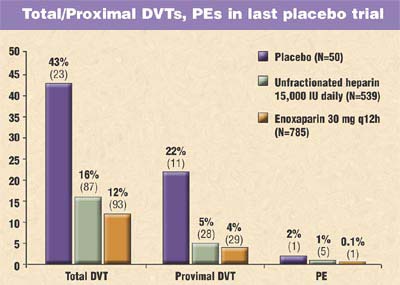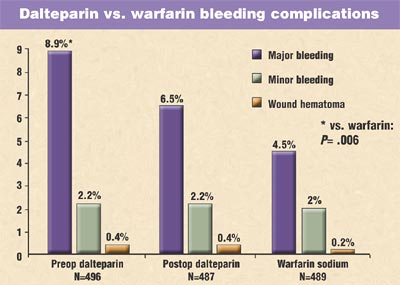DVT treatment varied and controversial
Surgeons use a range of treatments but still seek one that is more safe, effective and practical.
The use of prophylactic measures has repeatedly been shown effective in preventing deep vein thrombosis after knee and hip arthroplasty. Without prophylaxis, more than 20% of patients will develop the potentially fatal blood clots, so patients are treated with drugs, mechanical compression, or a combination of the two.
But the decision about exactly how to treat DVT prophylactically is complicated by a wide range of studies and strong opinions on every side. DVT prophylaxis was the subject of a recent symposium at the American Orthopaedic Association 116th Annual Meeting in Charleston, S.C.
Paul A. Lotke, MD, an orthopedic surgeon at the University of Pennsylvania Hospital, is a proponent of aspirin treatment for DVT prophylaxis. Lotke claims that its efficacy places it amid the ranks of other blood thinners, such as warfarin and heparin, without the potential dangerous side effects.
Clifford W. Colwell, MD, an orthopedist in La Jolla, Calif., disagreed. “There’s not a hematologist ... or orthopedist anywhere who uses aspirin on the venous side [to prevent DVT],” he said in a telephone interview with Orthopedics Today. “Everyone in the world has given up using it.”
Lotke countered that other drugs have a risk that is simply too high.
“Prophylaxis to reduce thromboembolic disease would be justified if the complications of such prophylaxis did not produce an alternative morbidity,” Lotke said in his presentation.
Difficult to manage
Colwell agreed that some prophylactic drugs — such as warfarin — can be troublesome for physician and patient alike.
“We’re all in natural agreement that warfarin does work ... but it is one of the most difficult drugs to manage.” Colwell said that the weekly monitoring required to ensure that the warfarin dosage is correct is nearly impossible for today’s private practitioner to manage. While physicians who work in hospitals may have access to a clinic where the blood work can be done, such testing can put an incredible strain on independent physicians.
According to Colwell, the ideal prophylactic method is effective, practical for use, cost effective and has shown a low risk of side effects. He said that while warfarin can be difficult to manage, there are other drugs, some currently on the market and others still awaiting approval, that have been proven much easier to use.
|
||||
Other drug choices
Low molecular weight heparin (LMWH) is probably the best known, and Colwell said it is his choice because it shows great efficacy and does not require monitoring. LMWH has shown such effectiveness, in fact, that investigators will no longer conduct placebo trials because the DVT risk for patients taking the placebo was so high. A study published in Clinical Orthopaedics and Related Research in 1995 found a 43% risk of DVT in patients taking the placebo vs. a 12% risk in patients on the low molecular weight heparin enoxaparin (Lovenox, Aventis Pharmaceuticals). Two percent of placebo patients developed PE while just 0.1% of the enoxaparin patients did.
Another study used dalteparin (Fragmin, Pharmacia), fragmented heparin. It was effective against warfarin at preventing venographic thrombosis but when administered preoperatively, as many Europeans surgeons do, it had a bleeding rate of 8.9%, which is close to double that of warfarin.
Clinical studies have shown that pentasaccharides, such as fondaparinux, have potential. One study showed a 0.9% risk of proximal DVT, compared to a 4.3% risk in patients taking enoxaparin.
But according to Colwell, a new drug not yet approved by the FDA has been showing a great deal of promise in clinical studies. Ximelagatran (Exanta, Astra-Zeneca) can be taken orally, an advantage over other drugs that must be injected subcutaneously.
“The great thing about medicine is that it’s always changing,” Colwell said. “If this drug gets approved, 99% of physicians in the world will be using it.”
Balance efficacy and safety
Both Colwell and Lotke agreed that it is most important to balance efficacy with safety. Lotke cited a study published last year comparing warfarin and enoxaparin in which the DVT rate was reduced to 25%. But, he said, the number of major bleeds — defined as retroperitoneal, intracranial, intraoperative — was unacceptable. According to Lotke, patients taking enoxaparin had a major bleed rate of 5.2% and, in a separate category, a clinically significant bleeding rate of 6.9%.
“That’s more than 12% either major or clinically significant bleeds,” he said.
But Lotke champions aspirin because, he said, it inhibits platelet function for the entire lifespan of the platelet. One study of 9000 patients using aspirin and intermittent pneumatic compression reduced DVT and kept fatal PE to 0.1%.
Colwell stressed the importance of treating DVT and pulmonary embolism despite the lack of safe, effective drugs, saying that the physical and monetary cost of DVT-related problems — such as post-thrombotic syndrome and chronic pulmonary hypertension — can be devastating. One study found that a patient admitted to the hospital for treatment of a pulmonary embolism can expect to pay $12,795, a figure that far exceeds the amount spent by heart attack and stroke victims.
Colwell called the present a “very exciting time” and predicted that in the next year the American College of Chest Physicians would grant A1 recommended status to pentasaccharides and fondaparinux.
For more information:
- Colwell C. We can and should treat/prevent the disease. Presented at the American Orthopaedic Association 116th Annual Meeting. June 11-14, 2003. Charleston, S.C.
- Lotke P. The treatment/prophylaxis is worse than the disease. Presented at the American Orthopaedic Association 116th Annual Meeting. June 11-14, 2003. Charleston, S.C.


